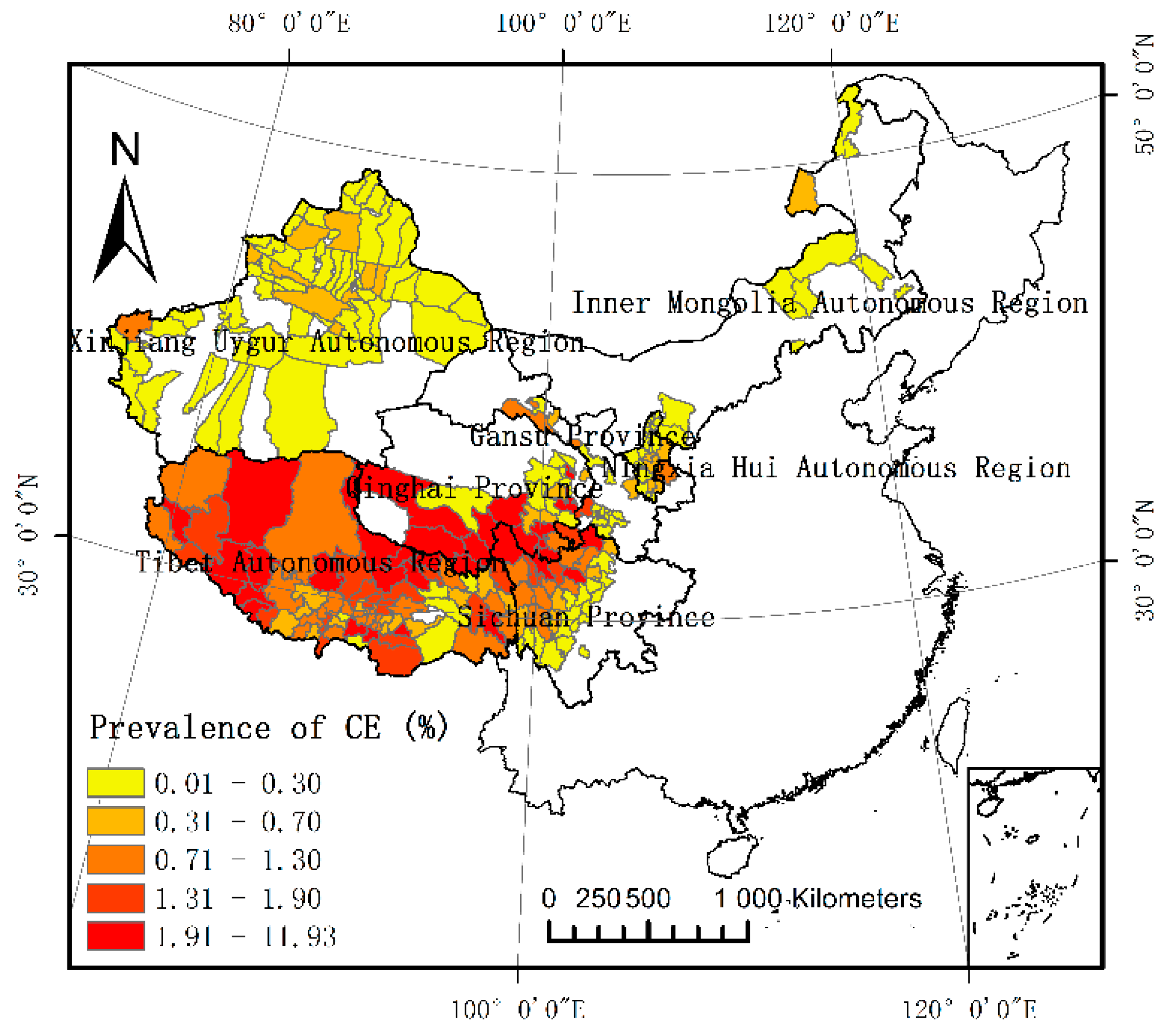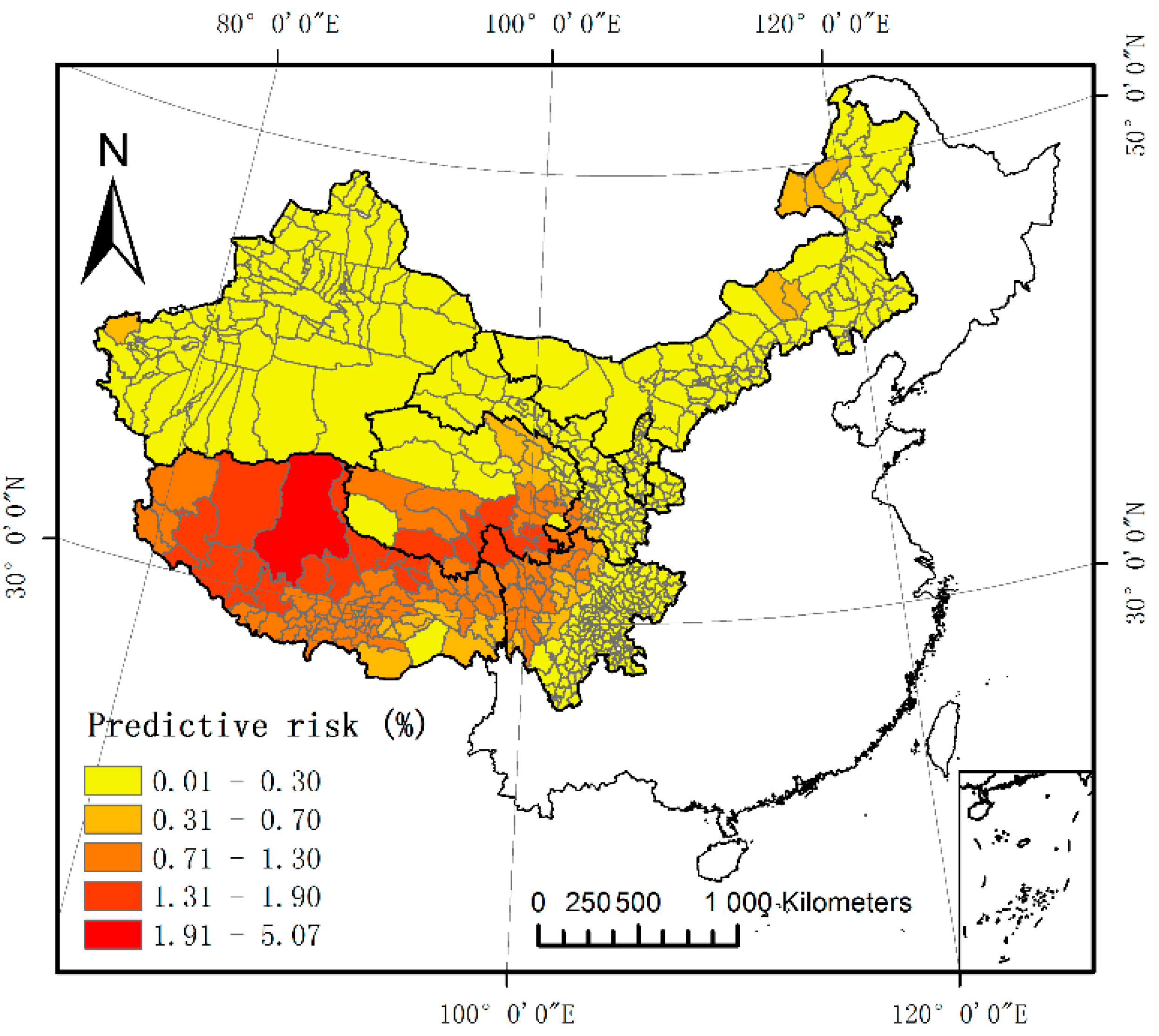Geographical Environment Factors and Risk Mapping of Human Cystic Echinococcosis in Western China
Abstract
:1. Introduction
2. Materials and Methods
2.1. Study Area
2.2. Data Sources and Processing
2.2.1. Prevalence of Human CE
2.2.2. Natural Geographical Environmental Data
2.2.3. Human Geographical Environment Data
2.3. Statistical Analysis and Risk Mapping
3. Results
3.1. Spatial Distribution of Existing Human CE
3.2. Univariate Analysis and Multivariate Analysis
3.3. Predicted Risk Distribution of Human CE
4. Discussion
5. Conclusions
Supplementary Materials
Author Contributions
Funding
Conflicts of Interest
References
- Restrepo, A.M.C.; Yang, Y.R.; Mcmanus, D.P.; Gray, D.J.; Giraudoux, P.; Barnes, T.S.; Williams, G.M.; Magalhães, R.J.S.; Hamm, N.A.S.; Clements, A.C.A. The landscape epidemiology of echinococcoses. Infect. Dis. Poverty 2016, 5, 13. [Google Scholar] [CrossRef] [PubMed]
- Moro, P.; Schantz, P.M. Echinococcosis: A review. Int. J. Infect. Dis. 2009, 13, 125–133. [Google Scholar] [CrossRef] [PubMed]
- Yang, Y.R.; Williams, G.M.; Craig, P.S.; McManus, D.P. Impact of increased economic burden due to human echinococcosis in an underdeveloped rural community of the people’s republic of china. PLoS Negl. Trop. Dis. 2010, 4, e801. [Google Scholar] [CrossRef] [PubMed]
- Eckert, J.; Deplazes, P. Biological, epidemiological, and clinical aspects of echinococcosis, a zoonosis of increasing concern. Clin. Microbiol. Rev. 2004, 17, 107–135. [Google Scholar] [CrossRef] [PubMed]
- Mcmanus, D.P.; Gray, D.J.; Zhang, W.; Yang, Y. Diagnosis, treatment, and management of echinococcosis. BMJ 2012, 344, e3866. [Google Scholar] [CrossRef] [PubMed]
- Rojas, C.A.A.; Thomas, R.; Lightowlers, M.W. Echinococcus granulosus sensu lato genotypes infecting humans—Review of current knowledge. Int. J. Parasitol. 2014, 44, 9–18. [Google Scholar] [CrossRef] [PubMed]
- Mcmanus, D.P. Current status of the genetics and molecular taxonomy of echinococcus species. Parasitology 2013, 140, 1617–1623. [Google Scholar] [CrossRef] [PubMed]
- Mcmanus, D.P.; Zhang, W.; Li, J.; Bartley, P.B. Echinococcosis. Lancet 2003, 362, 1295–1304. [Google Scholar] [CrossRef]
- World-Health-Organization. Available online: http://www.who.int/mediacentre/factsheets/fs377/en/ (accessed on 5 June 2018).
- Torgerson, P.R.; Krista, K.; Mellissa, M.; Natalie, R. The global burden of alveolar echinococcosis. PLoS Negl. Trop. Dis. 2010, 4, e722. [Google Scholar] [CrossRef] [PubMed] [Green Version]
- Budke, C.M.; Deplazes, P.; Torgerson, P.R. Global socioeconomic impact of cystic echinococcosis. Emerg. Infect. Dis. 2006, 12, 296–303. [Google Scholar] [CrossRef] [PubMed]
- Wang, Q.; Huang, Y.; Huang, L.; Yu, W.; He, W.; Zhong, B.; Li, W.; Zeng, X.; Vuitton, D.A.; Giraudoux, P. Review of risk factors for human echinococcosis prevalence on the qinghai-tibet plateau, china: A prospective for control options. Infect. Dis. Poverty 2014, 3, 3. [Google Scholar] [CrossRef] [PubMed]
- Wang, L.Y.; Wu, W.P.; Zhu, X.H. The endemic status of hydatidosis in china from 2004 to 2008. Chin. J. Zoonoses 2010, 26, 699–702. [Google Scholar]
- Carmona, C.; Perdomo, R.; Carbo, A.; Alvarez, C.; Monti, J.; Grauert, R.; Stern, D.; Perera, G.; Lloyd, S.; Bazini, R. Risk factors associated with human cystic echinococcosis in florida, uruguay: Results of a mass screening study using ultrasound and serology. Am. J. Trop. Med. Hyg. 1998, 58, 599–605. [Google Scholar] [CrossRef] [PubMed]
- Yang, Y.R.; Sun, T.; Li, Z.; Zhang, J.; Teng, J.; Liu, X.; Liu, R.; Zhao, R.; Jones, M.K.; Wang, Y. Community surveys and risk factor analysis of human alveolar and cystic echinococcosis in Ningxia Hui Autonomous Region, China. Bull. World Health Organ. 2006, 84, 714–721. [Google Scholar] [CrossRef] [PubMed]
- Veit, P.; Bilger, B.; Schad, V.; Schäfer, J.; Frank, W.; Lucius, R. Influence of environmental factors on the infectivity of echinococcus multilocularis eggs. Parasitology 1995, 110, 79–86. [Google Scholar] [CrossRef] [PubMed]
- Cadavid Restrepo, A.M.; Yang, Y.R.; McManus, D.P.; Gray, D.J.; Barnes, T.S.; Williams, G.M.; Soares Magalhães, R.J.; Clements, A.C.A. Environmental risk factors and changing spatial patterns of human seropositivity for Echinococcus spp. In Xiji County, Ningxia Hui Autonomous Region, China. Parasites Vectors 2018, 11, 159. [Google Scholar] [CrossRef] [PubMed]
- Ito, A.; Urbani, C.; Jiamin, Q.; Vuitton, D.A.; Dongchuan, Q.; Heath, D.D.; Craig, P.S.; Zheng, F.; Schantz, P.M. Control of echinococcosis and cysticercosis: A public health challenge to international cooperation in china. Acta Trop. 2003, 86, 3–17. [Google Scholar] [CrossRef]
- Zhang, W.B.; Xing, Y.; Wang, Y.H.; Xu, X. Community survey for human cystic echinococcosis in northwest china: A long term follow-up study. In Proceedings of the 2011 International Conference on Human Health and Biomedical Engineering, Jilin, China, 19–22 August 2011; pp. 636–639. [Google Scholar]
- Harandi, M.F.; Moazezi, S.S.; Saba, M.; Grimm, F.; Kamyabi, H.; Sheikhzadeh, F.; Sharifi, I.; Deplazes, P. Sonographical and serological survey of human cystic echinococcosis and analysis of risk factors associated with seroconversion in rural communities of kerman, iran. Zoonoses Public Health 2011, 58, 582–588. [Google Scholar] [CrossRef] [PubMed]
- Yang, Y.R.; Craig, P.S.; Ito, A.; Vuitton, D.A.; Giraudoux, P.; Sun, T.; Williams, G.M.; Huang, Z.; Li, Z.; Wang, Y. A correlative study of ultrasound with serology in an area in china co-endemic for human alveolar and cystic echinococcosis. Trop. Med. Int. Health 2007, 12, 637–646. [Google Scholar] [CrossRef] [PubMed]
- Wen, H. Epidemiology and control of echinococcosis in the northwestern of china and central asia. In Proceedings of the Research and Methods in Ecohealth and Conservation, Kunming, China, 6–7 November 2016. [Google Scholar]
- Yang, Y.R.; Clements, A.C.; Gray, D.J.; Atkinson, J.-A.M.; Williams, G.M.; Barnes, T.S.; McManus, D.P. Impact of anthropogenic and natural environmental changes on echinococcus transmission in ningxia hui autonomous region, the people’s republic of china. Parasites Vectors 2012, 5, 146. [Google Scholar] [CrossRef] [PubMed]
- Li, D.; Gao, Q.; Liu, J.; Feng, Y.; Ning, W.; Dong, Y.; Tao, L.; Li, J.; Tian, X.; Gu, J.; et al. Knowledge, attitude, and practices (KAP) and risk factors analysis related to cystic echinococcosis among residents in Tibetan communities, Xiahe County, Gansu Province, China. Acta Trop. 2015, 147, 17–22. [Google Scholar] [CrossRef] [PubMed]
- Yu, S.H.; Wang, H.; Wu, X.H.; Ma, X.; Liu, P.Y.; Liu, Y.F.; Zhao, Y.M.; Morishima, Y.; Kawanaka, M. Cystic and alveolar echinococcosis: An epidemiological survey in a tibetan population in southeast Qinghai, China. Jpn. J. Infect. Dis. 2008, 61, 242–246. [Google Scholar] [PubMed]
- Graham, A.J.; Atkinson, P.M.; Danson, F.M. Spatial analysis for epidemiology. Acta Trop. 2004, 91, 219–225. [Google Scholar] [CrossRef] [PubMed]
- Zhao, Y.; Wei-Ping, W.U. Application of spatial statistics on echinococcosis studies. Chin. J. Zoonoses 2015, 31, 272–276. [Google Scholar]
- National Bureau of Statistics of China. China Statistical Yearbook (2017); China Statistic Press: Beijing, China, 2017.
- Wei-Ping, W.U.; Wang, H.; Wang, Q.; Zhou, X.N.; Wang, L.Y.; Zheng, C.J.; Cao, J.P.; Xiao, N.; Wang, Y.; Zhu, Y.Y. A nationwide sampling survey on echinococcosis in China during 2012–2016. Chin. J. Parasitol. Parasit. Dis. 2018, 36, 1–14. [Google Scholar]
- China Meteorological Data Sharing Service System. Available online: http://data.cma.cn/ (accessed on 30 July 2018).
- Japan Space Systems. Available online: http://www.jspacesystems.or.jp (accessed on 30 July 2018).
- U.S. Geological Survey. Available online: https://lpdaac.usgs.gov/ (accessed on 30 July 2018).
- International Scientific & Technical Data Mirror Site, Computer Network Information Center, Chinese Academy of Sciences. Available online: http://www.gscloud.cn (accessed on 30 July 2018).
- Data Center for Resources and Environmental Sciences, Chinese Academy of Sciences (RESDC). Available online: http://www.resdc.cn (accessed on 30 July 2018).
- National Bureau of Statistics of the People’s Republic of China. Available online: http://www.stats.gov.cn/ (accessed on 30 July 2018).
- Senter, H.F. Applied linear statistical models. Publ. Am. Stat. Assoc. 1985, 103, 880. [Google Scholar] [CrossRef]
- Akossou, A.Y.J.; Palm, R. Impact of data structure on the estimators r-square and adjusted r-square in linear regression. Int. J. Math. Comput. 2013, 20, 84–93. [Google Scholar]
- Atkinson, J.A.; Gray, D.J.; Clements, A.C.; Barnes, T.S.; Mcmanus, D.P.; Yang, Y.R. Environmental changes impacting echinococcus transmission: Research to support predictive surveillance and control. Glob. Chang. Biol. 2013, 19, 677–688. [Google Scholar] [CrossRef] [PubMed]
- Federer, K.; Armuafernandez, M.T.; Hoby, S.; Wenker, C.; Deplazes, P. In vivo viability of echinococcus multilocularis eggs in a rodent model after different thermo-treatments. Exp. Parasitol. 2015, 154, 14–19. [Google Scholar] [CrossRef] [PubMed]
- Diker, A.I.; Tinar, R.; Senlik, B. Infectivity of echinococcus granulosus protoscolices under different conditions of temperature and humidity. J. Helminthol. 2008, 82, 297–300. [Google Scholar] [CrossRef] [PubMed]
- Hildreth, M.B.; Blunt, D.S.; Oaks, J.A. Lethal effects of freezing echinococcus multilocularis eggs at ultralow temperatures. J. Parasitol. 2004, 90, 841–844. [Google Scholar] [CrossRef] [PubMed]
- Eckert, J.; Gemmell, M.A.; Meslin, F.X.; Pawłowski, Z.S.; Eckert, J.; Gemmell, M.A.; Meslin, F.X.; Pawłowski, Z.S. WHO/OIE Manual on Echinococcosis in Humans and Animals: A Public Health Problem of Global Concern; World Organisation for Animal Health: Paris, France; World Health Organization: Geneva, Switzerland, 2001; pp. i–xvii. 265p. [Google Scholar]
- Hu, H.H.; Wu, W.P.; Guan, Y.Y.; Wang, L.Y.; Wang, Q.; Cai, H.X.; Huang, Y. A village-based multidisciplinary study on factors affecting the intensity of cystic echinococcosis in an endemic region of the tibetan plateau, china. Epidemiol. Infect. 2014, 142, 1214–1220. [Google Scholar] [CrossRef] [PubMed]
- Yu, W.; Huang, L.; Wang, X.; Yao, Y.; Ma, L.; Zelangruola; Li, Y.; Huang, Y.; Yi, D.; Wang, Q. Study on the seasonality of echinococcus granulosus infection in dogs in an area where cystic echinococcosis is prevalent. J. Pathog. Biol. 2012, 7, 280–281. [Google Scholar]
- Schantz, P.M.; Wang, H.; Qiu, J.; Liu, F.J.; Saito, E.; Emshoff, A.; Ito, A.; Roberts, J.M.; Delker, C. Echinococcosis on the Tibetan Plateau: Prevalence and risk factors for cystic and alveolar echinococcosis in Tibetan populations in Qinghai Province, China. Parasitology 2003, 127, S109–S120. [Google Scholar] [CrossRef] [PubMed]
- Yuan, R.; Wu, H.; Zeng, H.; Liu, P.; Xu, Q.; Gao, L.; Li, Y.; Li, R.; Huang, D.; Yu, C. Prevalence of and risk factors for cystic echinococcosis among herding families in five provinces in western china: A cross-sectional study. Oncotarget 2017, 8, 91568–91576. [Google Scholar] [CrossRef] [PubMed]
- Li, T.; Qiu, J.; Wen, Y.; Craig, P.S.; Chen, X.; Ning, X.; Ito, A.; Giraudoux, P.; Wulamu, M.; Wen, Y. Echinococcosis in tibetan populations, western sichuan province, china. Emerg. Infect. Dis. 2005, 11, 1866–1873. [Google Scholar]
- Patrick, G.; Francis, R.; Eve, A.; Iskender, Z.; Yang, Y.; Li, L.I.; Tiaoying, L.I.; Jean-Pierre, Q.; Feng, X.; Qian, W. Transmission ecosystems ofechinococcus multilocularisin china and central asia. Parasitology 2013, 140, 1655–1666. [Google Scholar]
- Li, T.Y.; Chen, X.W.; Ren, Z.; Qiu, J.M.; Qiu, D.C.; Ning, X.; Ito, A.; Hu, W.; Giraudoux, P.; Sako, Y. Widespread co-endemicity of human cystic and alveolar echinococcosis on the eastern Tibetan Plateau, northwest sichuan/southeast Qinghai, China. Acta Trop. 2010, 113, 248–256. [Google Scholar] [CrossRef] [PubMed]
- Moss, J.E.; Chen, X.; Li, T.; Qiu, J.; Wang, Q.; Giraudoux, P.; Ito, A.; Torgerson, P.R.; Craig, P.S. Reinfection studies of canine echinococcosis and role of dogs in transmission of Echinococcus multilocularis in Tibetan communities, Sichuan, China. Parasitology 2013, 140, 1685–1692. [Google Scholar] [CrossRef] [PubMed] [Green Version]
- Vaniscotte, A.; Raoul, F.; Poulle, M.L.; Romig, T.; Dinkel, A.; Takahashi, K.; Guislain, M.H.; Moss, J.; Tiaoying, L.; Wang, Q. Role of dog behaviour and environmental fecal contamination in transmission of echinococcus multilocularis in tibetan communities. Parasitology 2011, 138, 1316–1329. [Google Scholar] [CrossRef] [PubMed]
- Budke, C.M.; Campos-Ponce, M.; Qian, W.; Torgerson, P.R. A canine purgation study and risk factor analysis for echinococcosis in a high endemic region of the tibetan plateau. Vet. Parasitol. 2005, 127, 43–49. [Google Scholar] [CrossRef] [PubMed]
- Giraudoux, P.; Pleydell, D.; Raoul, F.; Quéré, J.P.; Wang, Q.; Yang, Y.; Vuitton, D.A.; Qiu, J.; Yang, W.; Craig, P.S. Transmission ecology of echinococcus multilocularis: What are the ranges of parasite stability among various host communities in china? Parasitol. Int. 2006, 55, S237–S246. [Google Scholar] [CrossRef] [PubMed]
- Marston, C.G.; Giraudoux, P.; Armitage, R.P.; Danson, F.M.; Reynolds, S.C.; Wang, Q.; Qiu, J.; Craig, P.S. Vegetation phenology and habitat discrimination: Impacts for e. Multilocularis transmission host modelling. Remote Sens. Environ. 2016, 176, 320–327. [Google Scholar] [CrossRef]
- Giraudoux, P.; Craig, P.S.; Delattre, P.; Bao, G.; Bartholomot, B.; Harraga, S.; Quéré, J.P.; Raoul, F.; Wang, Y.; Shi, D. Interactions between landscape changes and host communities can regulate echinococcus multilocularis transmission. Parasitology 2003, 127, 121–131. [Google Scholar] [CrossRef]
- Merino, V.; Westgard, C.M.; Bayer, A.M.; García, P.J. Knowledge, attitudes, and practices regarding cystic echinococcosis and sheep herding in peru: A mixed-methods approach. BMC Vet. Res. 2017, 13, 213. [Google Scholar] [CrossRef] [PubMed]
- Ye, H.E.; Yin, J. Analysis for epidemiological factors of echinococcosis. China Trop. Med. 2017, 17, 418–420. [Google Scholar]
- Yang, Y.R.; Craig, P.S.; Sun, T. Echinococcosis in Ningxia Hui Autonomous Region, northwest China. Trans. R. Soc. Trop. Med. Hyg. 2008, 102, 319–328. [Google Scholar] [CrossRef] [PubMed]
- Possenti, A.; Manzanoromán, R.; Sánchezovejero, C.; Boufana, B.; La, G.T.; Sileslucas, M.; Casulli, A. Potential risk factors associated with human cystic echinococcosis: Systematic review and meta-analysis. PLoS Negl. Trop. Dis. 2016, 10, e0005114. [Google Scholar] [CrossRef] [PubMed]
- Cheng, G.; Wu, T. Responses of permafrost to climate change and their environmental significance, Qinghai-Tibet Plateau. J. Geophys. Res. Earth Surf. 2007, 112. [Google Scholar] [CrossRef] [Green Version]
- Feng, X.; Qi, X.; Yang, L.; Duan, X.; Fang, B.; Gongsang, Q.; Bartholomot, B.; Vuitton, D.A.; Wen, H.; Craig, P.S. Human cystic and alveolar echinococcosis in the Tibet Autonomous Region (TAR), China. J. Helminthol. 2015, 89, 671–679. [Google Scholar] [CrossRef] [PubMed] [Green Version]



| Survey Date | 2012 | 2013 | 2014 | 2015 | 2016 |
|---|---|---|---|---|---|
| Number of counties investigated | 163 | 0 | 3 | 1 | 76 |
| Data Categories | Name | Source | Unit |
|---|---|---|---|
| Climatological data | Annual mean temperature | China Meteorological Data Sharing Service System | °C |
| Annual average precipitation | mm | ||
| DEM data | DEM | NASA | m |
| NDVI data | NDVI (Spring) | U.S. Geological Survey | - |
| NDVI (Summer) | - | ||
| NDVI (Autumn) | - | ||
| NDVI (Winter) | - | ||
| NDVI (Annual average) | - | ||
| LST data | LST (Spring) | International Scientific & Technical Data Mirror Site, Computer Network Information Center, Chinese Academy of Sciences | °C |
| LST (Summer) | °C | ||
| LST (Autumn) | °C | ||
| LST (Winter) | °C | ||
| LST (Annual average) | °C | ||
| Land use data | Arable area ratio | Data Center for Resources and Environmental Sciences, Chinese Academy of Sciences | - |
| Woodland area ratio | - | ||
| Grassland area ratio | - | ||
| Water area ratio | - | ||
| Residential area ratio | - | ||
| Unused area ratio | - | ||
| Population density data | Population density | National Bureau of Statistics of the People’s Republic of China | people/km2 |
| Religious beliefs data | Tibetan population ratio | - | |
| Mongolian population ratio | - | ||
| Hui population ratio | - | ||
| Illiteracy rate data | Illiteracy rate | - | |
| Occupation data | AOPR | - | |
| GDP data | GDP | 106 million RMB yuan |
| Factors | Univariate Analysis | Multivariate Analysis | ||
|---|---|---|---|---|
| Coefficient | p Value | Coefficient | p Value | |
| Population density | −0.50 ** | 0.00 | ||
| Tibetan population ratio | 0.63 ** | 0.00 | 1.56 | 0.00 |
| Mongolian population ratio | −0.44 ** | 0.00 | ||
| Hui population ratio | −0.44 ** | 0.00 | ||
| Illiteracy rate | 0.58 ** | 0.00 | ||
| AOPR | 0.23 ** | 0.00 | ||
| GDP | −0.56 ** | 0.00 | −0.01 | 0.00 |
| Annual mean precipitation | 0.31 ** | 0.00 | ||
| Annual mean temperature | −0.54 ** | 0.00 | ||
| DEM | 0.66 | 0.00 | ||
| NDVI (Spring) | −0.08 | 0.27 | ||
| NDVI (Summer) | −0.01 | 0.85 | ||
| NDVI (Autumn) | 0.00 | 0.98 | ||
| NDVI (Winter) | 0.25 ** | 0.00 | ||
| NDVI (Annual average) | 0.03 | 0.71 | ||
| LST (Spring) | −0.50 ** | 0.00 | −0.05 | 0.01 |
| LST (Summer) | −0.51 ** | 0.00 | ||
| LST (Autumn) | −0.51 ** | 0.00 | ||
| LST (Winter) | −0.44 ** | 0.00 | ||
| LST (Annual average) | −0.55 ** | 0.00 | ||
| Arable area ratio | −0.58 ** | 0.00 | ||
| Woodland area ratio | −0.10 | 0.18 | ||
| Grassland area ratio | 0.50 ** | 0.00 | 1.46 | 0.00 |
| Water area ratio | 0.00 | 0.95 | ||
| Residential area ratio | −0.50 ** | 0.00 | ||
| Unused area ratio | −0.07 | 0.36 | ||
© 2018 by the authors. Licensee MDPI, Basel, Switzerland. This article is an open access article distributed under the terms and conditions of the Creative Commons Attribution (CC BY) license (http://creativecommons.org/licenses/by/4.0/).
Share and Cite
Huang, D.; Li, R.; Qiu, J.; Sun, X.; Yuan, R.; Shi, Y.; Qu, Y.; Niu, Y. Geographical Environment Factors and Risk Mapping of Human Cystic Echinococcosis in Western China. Int. J. Environ. Res. Public Health 2018, 15, 1729. https://0-doi-org.brum.beds.ac.uk/10.3390/ijerph15081729
Huang D, Li R, Qiu J, Sun X, Yuan R, Shi Y, Qu Y, Niu Y. Geographical Environment Factors and Risk Mapping of Human Cystic Echinococcosis in Western China. International Journal of Environmental Research and Public Health. 2018; 15(8):1729. https://0-doi-org.brum.beds.ac.uk/10.3390/ijerph15081729
Chicago/Turabian StyleHuang, Duan, Rendong Li, Juan Qiu, Xiangdong Sun, Ruixia Yuan, Yuanyuan Shi, Yubing Qu, and Yingnan Niu. 2018. "Geographical Environment Factors and Risk Mapping of Human Cystic Echinococcosis in Western China" International Journal of Environmental Research and Public Health 15, no. 8: 1729. https://0-doi-org.brum.beds.ac.uk/10.3390/ijerph15081729





